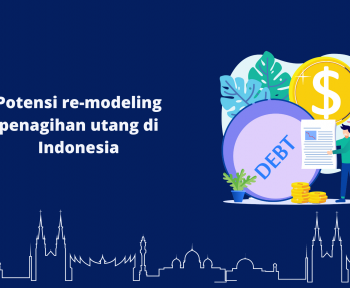In the fast growing financial services ecosystem in Indonesia, Peer-to-Peer (P2P) lending has emerged as a dynamic and popular lending model. With its huge capacity to address the credit needs of the underserved and unbanked population, peer-to-peer lending has gained significant traction in Indonesia, driven by the convergence of technology and finance.
While traditional banks may sometimes struggle to provide faster and easier access to loans to small businesses and individuals, P2P lending platforms offer a digital solution that connects borrowers (individuals or businesses) directly with potential lenders, eliminating the need for a middle layer such as financial institutions. These platforms create a marketplace where lenders can diversify their investments across a range of borrowers, reducing risks and promoting financial inclusion. For these and other reasons, P2P lending is emerging as a reassuring alternative to traditional banks.
The P2P lending framework consists of three parties:
- The lending platform is responsible for risk profiling and selecting eligible borrowers to apply for the loan
- Borrowers, which are individuals or legal entities (or companies)
- Lenders or investors, which are individuals or companies
Benefits of P2P Lending:
Financial Inclusion: As per a 2022 report, Indonesia ranked 28th on the Global Financial Inclusion Index, underscoring the pressing need and scope of widening credit access, tapping into the unbanked and underbanked segments of the population. P2P lending in Indonesia has unlocked opportunities for individuals and small businesses that were previously excluded from access to the formal financial system. Entrepreneurs, who find it challenging to secure loans from banks, can now access funds to grow their ventures, fostering innovation and economic growth.
Speed and Accessibility: P2P lending platforms leverage technology to expedite the lending process. Borrowers can submit loan applications online, and investors can browse these profiles to select suitable opportunities. This efficiency enables quicker access to funds for borrowers and higher returns for lenders.
Diversification: Investors can allocate smaller amounts across various loans, reducing the impact of potential defaults on their overall portfolio. This diversification lowers risk while potentially providing higher returns compared to traditional savings.
Empowerment: P2P lending empowers individuals to take control of their finances. Borrowers gain access to credit, and lenders can deploy their funds strategically to support projects they believe in.
Challenges and Regulations:
While P2P lending has brought about transformative change, challenges persist. Regulatory oversight is critical to ensuring that platforms operate ethically and transparently. In Indonesia, the Financial Services Authority (OJK) has implemented regulations to monitor P2P lending activities and safeguard the interests of both borrowers and lenders. Striking the right balance between innovation and consumer protection remains a delicate task.
In response to the challenges, OJK (Financial Services Authority) issued regulation POJK 10/2022 to crackdown on illegal and financially unhealthy fintech players, introducing new capital requirements, overhauling the license regime, and introducing minimum equity guidelines.
A. Capital and equity requirements:
- A Peer-to-Peer lending platform is now required to possess a minimum paid-up capital of 25 billion rupiah (equivalent to US$1.6 million), marking a substantial rise from the 2.5 billion rupiah (around US$165,000) specified in earlier regulatory guidelines.
- The OJK now requires P2P lending platforms to maintain a minimum equity of 12.5 billion rupiah (roughly $828,00). This obligation necessitates the gradual fulfilment of the requirement through successive tranches in the following manner:
- A minimum of 2.5 billion rupiah (US$ 165,000) within one year after the enactment of POJK 10/2022;
- A minimum of 7.5 billion rupiah (US$ 497,000) within two years after the enactment of POJK 10/2022;
The aforementioned rules do not apply to P2P lenders who already obtained their licenses from OJK or had applied for them prior to the publication of POJK 10/2022.
B. Licensing
In the past, a P2P platform aiming to establish operations in Indonesia had to initiate their presence by enlisting their business with the OJK. Following this, within one year of registration, they were obliged to petition the OJK for a business license. With the enactment of POJK 10/2022, the licensing process has been restructured to eliminate the initial registration phase. Consequently, P2P lenders are now only required to acquire a license directly from the OJK.
Nevertheless, a new stipulation has been introduced, necessitating that P2P lenders attain registration as an Electronic System Operator (ESO) with the Ministry of Communication and Informatics. Following the issuance of the business license issued by the OJK, this specific registration should be successfully completed within 30 calendar days.
C. Lock-up period
Once the P2P operator secures the license from OJK, they are prohibited from changing the controlling shareholders or having new shareholders for a period of three years.
D. Lending limit
The maximum loan amount per loan is 2 billion rupiah (US$132,000).
The road ahead
As Indonesia’s P2P lending ecosystem matures, it is likely to witness a surge in innovation, technology integration, and partnerships with traditional financial institutions. Improved credit scoring models and risk assessment tools will further enhance the credibility of borrowers and the confidence of lenders. Additionally, the growth of P2P lending will contribute to the digitization of financial services, fostering financial literacy and inclusion across diverse segments of society.
P2P lending has ushered in a new era of financial inclusion and accessibility in Indonesia. The present P2P model serves as a glimpse into what lies ahead—a landscape wherein higher-yield loans are set to expand their share while the cash / multipurpose sector maintains its growth trajectory owing to its scale and pressing demand.
The industry’s primary hurdle lies in building a positive reputation through enhanced collection practices and more favourable interest rates. Consistent improvement on these fronts would bolster trust among regulators, stakeholders, and the wider populace.
As technology continues to evolve, P2P lending platforms will play a pivotal role in transforming Indonesia’s economic landscape, empowering individuals, businesses, and investors to engage in a more transparent, efficient, and equitable financial ecosystem. The rise of P2P lending stands as a testament to the transformative power of innovation, offering a glimpse into the future of finance in Indonesia and beyond.
FAQs:
- What are some of the most common P2P lending platforms in Indonesia?
Indonesia’s P2P lending landscape has witnessed significant growth, with several platforms making their mark in the industry. Some of the common and well-known P2P lending platforms in Indonesia include:
- Modalku (Funding Societies): One of the pioneers in Indonesian P2P lending, Modalku, now known as Funding Societies, provides both business and personal loans. They have established a strong presence by connecting investors with SMEs seeking funding.
- Amartha: Amartha focuses on micro-lending to rural and underserved communities. Their platform empowers individuals to invest in and support micro-entrepreneurs across Indonesia.
- KoinWorks: KoinWorks is a digital lending platform catering to both borrowers and lenders. They offer a range of loan options, including personal loans and business financing, with a focus on inclusivity and ease of use.
- Investree: Investree facilitates lending to SMEs through a peer-to-peer platform. They use technology to provide transparent and efficient lending solutions for businesses.
- Tunaiku: Tunaiku is a peer-to-peer lending platform that specializes in personal loans and is owned by Amar Bank. It has garnered attention for its simplicity and quick loan approval process.
- Mekar: Mekar is dedicated to promoting financial inclusion by connecting investors with micro and small businesses in Indonesia. Their platform allows individuals to invest in micro-loans for positive social impact.
- Cicil: Cicil is geared towards providing education financing to students and parents. It enables students to pay for their education through instalment plans, making higher education more accessible.
- DANA: While primarily a digital wallet and payment platform, DANA has also ventured into P2P lending by offering short-term loans for users. Their vast user base gives them an advantage in reaching borrowers.
These platforms highlight the diverse range of P2P lending services available in Indonesia, catering to various segments of the population, from micro-entrepreneurs and SMEs to individuals seeking personal loans or education financing.
2. What are some of the benefits of P2P lending?
Peer-to-Peer (P2P) lending offers several benefits for both borrowers and investors, contributing to its popularity as an alternative financial model:
Benefits for Borrowers:
- Access to Funding: P2P lending provides an alternative source of funding for individuals and small businesses who might have difficulty securing loans from traditional banks due to limited credit history or collateral.
- Quick Approval: P2P lending platforms often have streamlined application processes and quicker approval times compared to traditional banks, allowing borrowers to access funds when needed.
- Competitive Rates: P2P lending can offer competitive interest rates, especially for borrowers with good credit. This can make it a more cost-effective option compared to traditional lending.
- Flexibility: Borrowers can often choose the loan terms and repayment schedules that align with their financial situation, giving them more flexibility.
- Diversification of Loan Options: P2P lending can cover a wide range of loan purposes, from personal loans to business financing, catering to diverse borrower needs.
Benefits for Investors:
- Higher Returns: P2P lending has the potential to offer higher returns compared to traditional savings accounts or other low-risk investments.
- Diversification: P2P lending allows investors to diversify their portfolio by allocating funds across different loans and borrowers, reducing overall risk.
- Control and Choice: Investors have the ability to choose the loans they want to fund, based on their risk appetite, return expectations, and preferences.
- Access to New Asset Class: P2P lending provides investors access to a previously untapped asset class, allowing them to explore new avenues for generating income.
- Direct Impact: Investors can see their funds directly contributing to individual borrowers or small businesses, which can be appealing for those looking for tangible impact from their investments.
- Transparency: P2P platforms often provide detailed information about borrowers and their creditworthiness, enabling investors to make informed decisions.
3. How popular is P2P lending in Indonesia?
Peer-to-Peer (P2P) lending has gained significant popularity in Indonesia over the past few years. The country’s large population, growing middle class, and increasing digital adoption have contributed to the success of P2P lending platforms. Several factors contribute to its popularity:
- Access to Funding: P2P lending addresses the gap in access to credit for individuals and small businesses that might struggle to secure loans from traditional banks due to various reasons, including limited credit history.
- Digital Penetration: Indonesia’s widespread adoption of digital technology, especially smartphones, has facilitated the growth of P2P lending platforms. Many people can access these platforms easily.
- Financial Inclusion: P2P lending promotes financial inclusion by offering financing options to those who were previously excluded from the formal financial system.
- Ease of Use: P2P lending platforms have user-friendly interfaces, making it easy for borrowers and lenders to participate, even without extensive financial expertise.
- High Returns: Investors seeking higher returns on their investments are drawn to P2P lending platforms, especially when compared to traditional savings options.
- Diverse Loan Types: P2P lending platforms in Indonesia offer various types of loans, catering to personal loans, microloans, SME financing, and more.
- Regulation: The regulatory framework put in place by the Financial Services Authority (OJK) has provided a level of trust and legitimacy to the industry, attracting more participants.
- Alternative Investment: P2P lending offers an alternative investment avenue for those looking to diversify their portfolio beyond traditional options.





